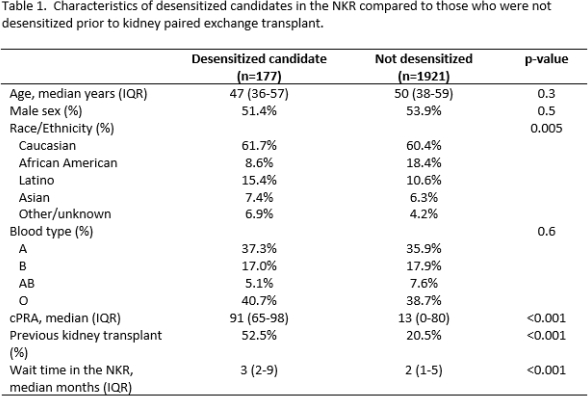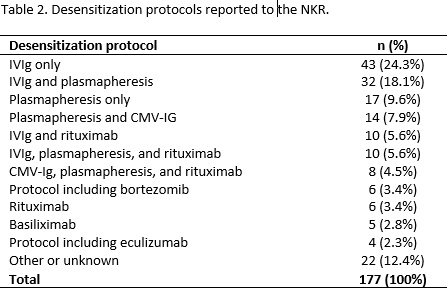Desensitization to Facilitate Matching in a Large, National Kidney Paired Exchange Clearinghouse
C. Holscher,1 A. Thomas,1 K. Jackson,1 C. Haugen,1 M. Ronin,2 A. Waterman,3,4 A. Massie,1,5 J. Garonzik Wang,1 D. Segev.1,5
1Johns Hopkins School of Medicine, Baltimore
2National Kidney Registry, New York
3David Geffen School of Medicine at UCLA, Los Angeles
4Terasaki Research Institute, Los Angeles
5Johns Hopkins School of Public Health, Baltimore.
Meeting: 2018 American Transplant Congress
Abstract number: A163
Keywords: Donors, Kidney transplantation, Sensitization, unrelated
Session Information
Session Name: Poster Session A: Kidney Paired Exchange
Session Type: Poster Session
Date: Saturday, June 2, 2018
Session Time: 5:30pm-7:30pm
 Presentation Time: 5:30pm-7:30pm
Presentation Time: 5:30pm-7:30pm
Location: Hall 4EF
In kidney paired exchange (KPE) programs, the use of incompatible transplantation has been necessary to prevent long waiting times for sensitized candidates and to facilitate a maximal number of matches. The prevalence and characteristics of candidates who undergo desensitization as part of KPE is unclear.
Methods: We studied National Kidney Registry (NKR)-matched kidney transplant recipients 2011-2017 to describe the practice of desensitization in a large national KPE clearinghouse in the US.
Results: Out of 2098 NKR-matched recipients, 177 (8.4%) underwent desensitization prior to transplant. These transplants occurred at 35 (41.2%) transplant centers out of the 85 that had at least one NKR-matched recipient during the study period. Desensitized recipients, in comparison to compatible recipients, had similar age and sex but were less likely African American (8.6% vs. 18.4%, p=0.005, Table 1). Desensitized recipients had a median PRA of 91% compared to 13% for compatible recipients (p<0.001), and were more likely to have had a previous kidney transplant (52.5% vs. 20.5%, p<0.001, Table 1). Desensitized recipients experienced a longer wait to NKR match (median 3 months vs. 2 months, p<0.001). The most frequent desensitization protocols reported included IVIg only (24.3%), IVIg with plasmapheresis (18.1%), and plasmapheresis only (9.6%, Table 2).
Conclusion: Improved understanding of national practices in incompatible transplantation as part of KPE can help facilitate transplantation for sensitized candidates.
CITATION INFORMATION: Holscher C., Thomas A., Jackson K., Haugen C., Ronin M., Waterman A., Massie A., Garonzik Wang J., Segev D. Desensitization to Facilitate Matching in a Large, National Kidney Paired Exchange Clearinghouse Am J Transplant. 2017;17 (suppl 3).
To cite this abstract in AMA style:
Holscher C, Thomas A, Jackson K, Haugen C, Ronin M, Waterman A, Massie A, Wang JGaronzik, Segev D. Desensitization to Facilitate Matching in a Large, National Kidney Paired Exchange Clearinghouse [abstract]. https://atcmeetingabstracts.com/abstract/desensitization-to-facilitate-matching-in-a-large-national-kidney-paired-exchange-clearinghouse/. Accessed December 12, 2025.« Back to 2018 American Transplant Congress


